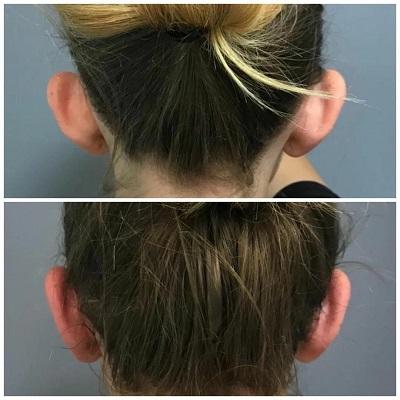Common Ear Deformities Corrected by Otoplasty

Our ears play a significant role in defining facial balance, symmetry, and overall aesthetics. However, not everyone is born with perfectly shaped ears, and some individuals may suffer from ear deformities due to genetics, trauma, or developmental issues. Fortunately, Ear Reshaping in Islamabad—also known as otoplasty—offers an effective solution to correct a variety of common ear deformities. This cosmetic procedure has become increasingly popular among both children and adults looking to improve their ear shape and, in turn, their self-confidence. Clinics like SKN Cosmetics clinic offer professional and safe ear reshaping procedures tailored to individual needs.
In this blog, we will explore the most common ear deformities that can be corrected through otoplasty, shedding light on the treatment options, benefits, and what patients can expect.
What Is Otoplasty?
Otoplasty is a surgical procedure that involves reshaping the external ear (auricle) to improve its size, shape, or position. It is commonly used to correct prominent, misshapen, or asymmetrical ears. The surgery is performed under local or general anesthesia depending on the patient's age and case complexity, and recovery is typically quick with minimal discomfort.
Otoplasty is one of the few cosmetic surgeries that is equally safe and effective for both children and adults.
Why Correct Ear Deformities?
Ear deformities can be both congenital (present at birth) or acquired (developed later due to trauma or injury). These irregularities are more than just cosmetic concerns; in some cases, they can affect functionality, such as wearing glasses, hearing aids, or even leading to psychological discomfort due to bullying or self-consciousness.
Correcting ear deformities through otoplasty helps in:
-
Restoring natural ear shape and symmetry
-
Improving overall facial harmony
-
Boosting self-confidence and emotional well-being
-
Enhancing comfort for eyewear or headgear
Common Ear Deformities Treated with Otoplasty
1. Protruding Ears (Prominent Ears)
Protruding ears are among the most common deformities corrected by otoplasty. This condition is typically caused by underdeveloped ear cartilage or excessive cartilage that makes the ears stick out more than 2 cm from the side of the head.
Treatment:
Otoplasty reshapes the cartilage and repositions the ear closer to the head, creating a more natural and balanced appearance.
Ideal for:
Both children (as young as 5) and adults who are self-conscious about how far their ears stick out.
2. Cup Ear (Constricted Ear)
Cup ear, also known as constricted ear, refers to a condition where the upper part of the ear is tight, rolled, or appears as if it’s folded inward. This deformity is caused by abnormal development of the ear cartilage.
Treatment:
Cartilage reshaping or grafting is used during otoplasty to correct the ear's contour and restore a normal appearance.
Severity Levels:
Cup ear deformities range from mild to severe, with surgical approaches customized based on the condition's complexity.
3. Lop Ear
Lop ear occurs when the top part of the ear bends downward and forward, giving the ear a droopy appearance. This condition is congenital and can become more noticeable as a child grows.
Solution:
Otoplasty lifts and supports the folded cartilage, restoring the ear’s natural upright shape.
Common in:
Infants and young children, though adults can also seek corrective surgery later in life.
4. Stahl’s Ear (Spock Ear)
Stahl’s ear is characterized by a pointed shape at the top of the ear, often due to an extra cartilage fold. This gives the ear an unusual, elf-like appearance.
Treatment with otoplasty:
The extra fold of cartilage is removed or reshaped, and the ear is molded into a more typical rounded contour.
Aesthetic goal:
To achieve a more natural ear shape that aligns with conventional anatomical standards.
5. Macrotia (Large Ears)
Macrotia is a condition where the ears are disproportionately large compared to the rest of the face. While the ears may not protrude, their size can draw unwanted attention and affect facial balance.
Otoplasty for macrotia:
Surgeons reduce the size of the ears by removing or reshaping part of the cartilage while maintaining a natural appearance.
Suitable for:
Individuals who are otherwise satisfied with ear positioning but desire a size reduction.
6. Cryptotia (Hidden Ear)
In cryptotia, the upper portion of the ear appears hidden beneath the scalp skin. This can cause difficulty with wearing glasses or headgear and results in a misshapen upper ear.
Surgical approach:
Otoplasty involves reconstructing the upper ear fold and freeing it from the scalp to create a more defined and accessible ear structure.
Often corrected in:
Early childhood, though adults can also opt for the procedure.
7. Microtia
Microtia is a more severe congenital condition where the external ear is underdeveloped or absent. It may occur on one or both sides and is often associated with hearing impairment.
Reconstructive otoplasty involves:
Creating a new ear using rib cartilage or synthetic materials. This is a complex, multi-stage procedure often performed in childhood.
Goal:
To restore both the appearance and potential hearing function (in coordination with audiology specialists).
8. Ear Deformities Caused by Trauma or Injury
Injuries from burns, accidents, sports, or piercings can lead to ear deformities such as torn earlobes, collapsed cartilage, or scarring.
Examples include:
-
Cauliflower ear from wrestling or boxing
-
Torn lobes from heavy earrings
-
Burns or lacerations
Corrective treatment:
Otoplasty is used to reconstruct and reshape the ear using skin grafts, cartilage repair, or scar revision techniques.
Who Is an Ideal Candidate?
You may be an ideal candidate for otoplasty if you or your child:
-
Has one of the deformities listed above
-
Is in good physical health
-
Has realistic expectations
-
Is bothered by the appearance of the ears
-
Is over the age of 5 (for pediatric cases)
A certified cosmetic surgeon can provide a complete assessment to determine the best treatment plan.
Recovery and Results
The recovery process after otoplasty is generally smooth and relatively quick:
-
Downtime: Most patients return to school or work in 5–7 days
-
Discomfort: Mild swelling and bruising may occur initially
-
Aftercare: A headband is often recommended to protect the ears during healing
-
Final results: Become more visible within a few weeks, with full results seen after several months
The results are long-lasting and can significantly improve appearance and self-confidence.
Conclusion: Restore Confidence with Professional Ear Reshaping
Living with an ear deformity—whether congenital or acquired—can affect one’s quality of life in many ways. Thankfully, modern cosmetic procedures like otoplasty make it possible to correct these issues with precision, safety, and natural-looking results.
If you or your child is seeking a solution, Ear Reshaping in Islamabad is a reliable and effective option. For expert care, consider the SKN Cosmetics clinic, a trusted name in cosmetic surgery offering tailored treatments, skilled surgeons, and state-of-the-art facilities. Book a consultation today and take the first step toward a more balanced and confident appearance.







